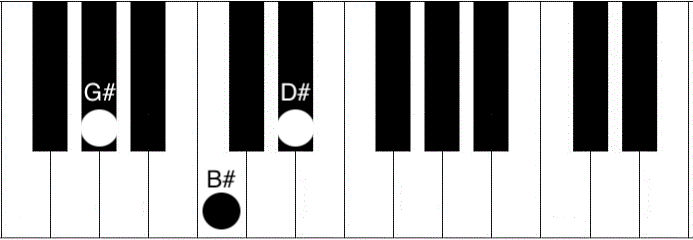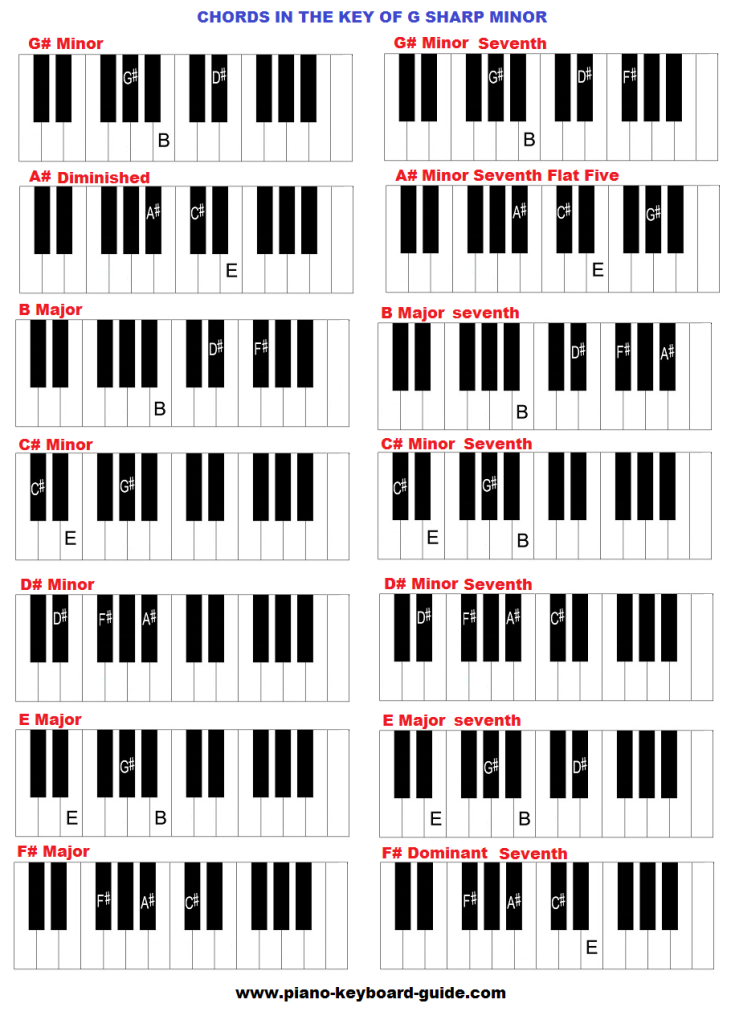G# on piano refers to the musical note G sharp, which is a black key on the keyboard. It’s the note between G and A and also can be denoted as Ab (A flat).
The G# note holds a distinct place on the piano, situated just above the white G key and before the A key. Understanding the layout of black keys, including G#, is vital for pianists of all levels. These sharps and flats allow musicians to explore a wider range of melodies and harmonies, enriching the music they play.
As a beginner, familiarizing yourself with these half-step intervals, such as G#, is crucial for mastering scales and chords — a stepping stone to advanced piano technique. For an aspiring pianist, mastering the positioning and utilization of G# can unlock a fuller sound palette and facilitate smoother transitions in various musical pieces.
The Basics Of Piano Keys
Understanding the layout of piano keys is vital for anyone learning to play the instrument. The piano keyboard consists of black and white keys. Each key produces a different note when pressed.
Identifying G#
G#, also known as G sharp, is a black key on the piano. It is found immediately to the right of the white key G. On a standard 88-key piano, G# appears multiple times, each an octave apart.
- Black keys are either sharp (#) or flat (b), depending on the note they are related to.
- Each G# is easy to spot. It’s the first black key in the set of three black keys.
Comparison With Other Notes
G# is one semitone higher than G and one semitone lower than A. It’s also known as Ab (A flat) when it is one semitone lower than A.
| Note | Description |
|---|---|
| G | White key directly to the left of G# |
| G# / Ab | Black key right above G and below A |
| A | White key directly to the right of G# |
Recognizing the relationship between notes is key to mastering the piano. Identify a G# and understand its context among other notes to unlock new melodies.

Credit: pianochordcharts.net
Positioning G# On The Keyboard
Discovering the G# note on a piano keyboard is a simple yet vital step in mastering piano play. G# or G sharp is a black key, nestled between other keys.
Locating G# Among White Keys
G# lies directly to the right of its white key counterpart, G. If you look closely, you’ll notice that each black key sits between two white keys. This positioning forms a pattern that repeats across the piano keyboard.
- Identify the group of three black keys.
- The first black key in the trio is your target, G#.
- G# is also known as Ab, or A flat, which is the same key but approached from a different angle.
Relation To G And A
Enhancing your understanding of G# involves knowing its neighbors: the G and A keys. Below is how G# relates to them:
| White Key | Adjacent Black Key | Note Name |
|---|---|---|
| G | Right of G | G# |
| A | Left of A | G# (Ab) |
G# and Ab are enharmonic, meaning they are the same key played with a different intent. In practice, this versatility allows musicians to explore diverse harmonic options.
Playing G# In Music
G#, or G sharp, is a black key on the piano. It sits between the white keys G and A. Playing it is essential for a variety of musical pieces. This note adds richness to scales and chords. It helps create beautiful melodies. Let’s explore the use of G# in different aspects of piano music.
G# In Scales
G# appears in several key scales. In the E Major scale, it acts as the third note. Similarly, in C# Minor, G# is the fifth note. Below is a table that outlines its place in different scales:
| Scale | Position of G# |
|---|---|
| E Major | Third note |
| C# Minor | Fifth note |
| A Major | Seventh note |
G# In Chords
Chords that include G# have a distinctive sound. For instance, the G# Minor chord includes notes G#, B, and D#. Here’s a list of common chords containing G#:
- G# Major: G# – C – D#
- G# Minor: G# – B – D#
- C# Major: C# – E# – G#
- A Major: A – C# – E
Melodic Uses Of G#
Melodic lines often use G# to add expression. It’s a pivotal note in classical and pop music. Some songs may use G# to build tension before resolving to another note. Here are a couple of melodic patterns that feature G#:
- A – G# – F# – E (Descending Melody)
- G# – A – B – C# (Ascending Melody)
Remember, whether playing scales, building chords, or crafting melodies, G# is a key note to understand and master on the piano.

Credit: littleredpiano.com
G# In Different Octaves
On the piano, G#, also known as Ab (A flat), resonates uniquely across various octaves. This single note can embody multiple shades of sound. Each octave reveals a new character of G# that is fascinating to explore. From the deep growl in the lower registers to the piercing cry in the higher, G# is a showcase of the piano’s versatility.
Exploring G# On Various Octaves
The piano keyboard stretches over seven full octaves and a minor third, from A0 to C8. In each of these octaves, G# has a spot, and it’s interesting to note how it changes. Let’s take a tour:
- Subcontra octave (A0 – G#1): Here, G# is deep and rumbling.
- Great octave (A1 – G#2): The depth remains but with a clearer tone.
- Small octave (A2 – G#3): The middle ground, where G# starts to sing.
- One-lined octave (A3 – G#4): A staple for melodies, G# is rich and full.
- Two-lined octave (A4 – G#5): The note becomes bright and commanding.
- Three-lined octave (A5 – G#6): Here, G# is sharp, almost whistle-like.
- Four-lined octave (A6 – G#7) and beyond: G# reaches a piercing, crystal clarity.
Pitch Variations And Sound Quality
G# transforms as you climb or descend the piano keys. Lower octaves offer a warm, resonate hum, ideal for creating rich harmonies. As you move to the middle of the piano, G# takes on a balanced quality, perfect for both harmony and melody. Ascend further, and G# emerges with brilliance, standing out in any composition.
| Octave Range | Pitch Character |
|---|---|
| Lower octaves (G#1 – G#3) | Warm, deep, harmonious |
| Middle octaves (G#3 – G#5) | Balanced, clear, versatile |
| Higher octaves (G#5 – G#7) | Bright, sharp, leading |
Enhancing Piano Skills With G#
Mastering G# on the piano can sparkle up your playing style. This note adds a dash of sophistication to pieces in certain keys. Get ready to dive into the world of G# and unlock new musical possibilities.
Practice Exercises For G#
Piano practice is key to making G# your friend. Engaging in exercises will build muscle memory and confidence. Let’s explore ways to weave G# into your routine.
- Scale Work: Start with the G# minor scale. Play it slowly, then increase speed.
- Arpeggios: Practice G# minor and major arpeggios to grasp different tonalities.
- Chord Progressions: Include chords like G#maj, G#min, and G#7 in your practice.
- Finger Strength: Use Hanon exercises, focusing on the G# note to build dexterity.
Tips For Smooth Transitions Involving G#
Transitioning to and from G# can be smooth with the right technique. Follow these tips to glide across the keys.
- Thumb Tucking: When ascending, tuck your thumb under your third finger at G#.
- Finger Crossing: While descending, cross your third finger over your thumb after G#.
- Hand Position: Keep your hand relaxed to easily reach G#.
- Listen Carefully: Tune in to the sound of G# to balance its tone with other notes.
Remember, steady practice and mindful playing are your allies in mastering G# on the piano.

Credit: www.piano-keyboard-guide.com
How Can I Play G# on the Piano?
To play G# on the piano, position your right hand’s third finger on the black key immediately to the right of G. Press down with firm, controlled pressure. As you practice, you’ll discover the piano passion and master playing G# without difficulty. Keep at it and enjoy the process!
How Does G# Relate to the Chords and Melodies in Will Young’s Piano Room?
In Will Young’s Piano Room, G# serves as a pivotal note, enhancing both chords and melodies. Its rich resonance adds depth to will young’s performance, creating harmonic layers that elevate the emotional impact of each song. This connection transforms his pieces into unforgettable musical experiences.
Frequently Asked Questions Of What Is G# On Piano
How Do You Play G# On Piano?
To play G# on the piano, find the black key directly to the right of the G key and press it down. This black key produces the G# note.
What Is The G# Chord?
The G# chord is a major chord played on the fourth fret, consisting of the notes G#, C, and D#. It’s common in various music genres and can be played on guitar, piano, and other instruments.
What Are The Notes In G#?
The notes in a G# major scale are G#, A#, B#, C#, D#, E#, and F##.
What Is The G# Major Scale On Piano?
The G# major scale on piano consists of the notes G#, A#, B#, C#, D#, E#, and Fx. Each key follows a whole or half-step pattern.
Conclusion
Exploring the G# note on piano unlocks a realm of harmonic possibilities. It acts as a musical stepping stone, enhancing melodies and chords alike. Whether you’re improvising or following a score, understanding G# is essential. Embrace this pivotal tone and let your piano journey flourish.
Keep practicing, and the elegant sound of G# will soon resonate effortlessly under your fingertips.
